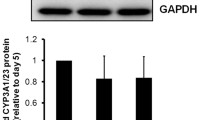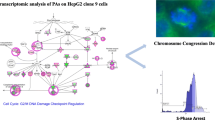Abstract
We investigated the involvement of diverse protein kinases and phosphatases in the transduction pathways elicited by phenobarbital (PB), a well-known inducer of some hepatic cytochromes P450 (CYP). Different inhibitors or activators of protein kinases or phosphatases were assessed for their ability to modulate PB-induction of CYP2B and CYP3A mRNA expression. Rat hepatocytes in primary culture were treated with the test compounds one hour prior to, and then continuously, in the absence or presence of 1 mmol/L PB for 24 h. By northern blot analysis of CYP2B1/2 and 3A1/2 gene expression, we first confirmed the negative role of the adenosine 3′:5′ cyclic monophosphate (cAMP)/protein kinase A pathway and the positive role of some serine/threonine protein phosphatases in the mechanism of PB-induction. The present data further suggested that Ca2+/calmodulin-dependent protein kinases II (independently of Ca2+) and extracellular signal-regulated kinases 1/2 (ERK1/2) might function respectively as positive and negative regulator in the PB-induction of CYP2B and CYP3A. In contrast, protein kinases C and phosphatidylinositol-3-kinase did not appear to be involved, while the role of tyrosine kinases remained unclear. We conclude that a complex network of phosphorylation/dephosphorylation events might be crucial for PB-induction of rat CYP2B and CYP3A.
Similar content being viewed by others
References
Aubrecht J, Hirsch-Ernst KI, Becker-Rabbenstein V, Kahl GF, Taniguchi H, Hohne MW. Induction of cytochrome P-4502B1-related mouse cytochrome P-450 and regulation of its expression by epidermal growth factor/transforming growth factor alpha in primary hepatocyte culture. Biochem Pharmacol. 1995;50:781-5.
Baffet G, Corcos L. The liver-specific response to phenobarbital involves a transient increase in phosphorylation of a 34-kDa nuclear protein in rat liver and in hepatocytes in culture. Biochem Biophys Res Commun. 1995;216:947-56.
Bani M-H, Tohkin M, Ushio F, Fukuhara M. Evidence for involvement of cAMP-dependent pathway in the phenobarbital-induced expression of a novel hamster cytochrome P450, CYP3A31. Arch Biochem Biophys. 1998;356:100-6.
Beck NB, Omiecinski CJ. Lack of modulation by phenobarbital of cyclic AMP levels or protein kinase A activity in rat primary hepatocytes. Biochem Pharmacol. 1999;58:1109-14.
Brown SES, Quattrochi LC, Guzelian PS. Characterization of a pretranscriptional pathway for induction by phenobarbital of cytochrome P450 3A23 in primary cultures of adult rat hepatocytes. Arch Biochem Biophys. 1997;342:134-42.
Chomczynski P, Sacchi N. Single-step method of RNA isolation by acid guanidium thiocyanate-phenol-chloroform extraction. Anal Biochem. 1987;162:156-9.
Conney AH. Pharmacological implications of microsomal enzyme induction. Pharmacol Rev. 1967;19:317-66.
Conney AH. Induction of microsomal enzymes by foreign chemicals and carcinogenesis by polycyclic aromatic hydrocarbons: G.H.A. Clowes Memorial Lecture. Cancer Res. 1982;42:4875-917.
Fukunaga K, Rich DP, Soderling TR. Generation of the Ca2(+)-independent form of Ca2+/calmodulin-dependent protein kinase II in cerebellar granule cells. J Biol Chem. 1989;264: 21830-6.
Galisteo M, Marc N, Fautrel A, Guillouzo A, Corcos L, Lagadic-Gossmann D. Involvement of cyclic nucleotide-and calcium-regulated pathways in phenobarbital-induced cytochrome P-450 3A expression in mouse primary hepatocytes. J Pharmacol Exp Ther. 1999;290:1270-7.
Guguen-Guillouzo C, Clement B, Baffet G, et al. Maintenance and reversibility of active albumin secretion by adult rat hepatocytes co-cultured with another liver epithelial cell type. Exp Cell Res. 1983;143:47-54.
Honkakoski P, Negishi M. Protein serine/threonine phosphatase inhibitors suppress phenobarbital-induced Cyp2b10 gene transcription in mouse primary hepatocytes. Biochem J. 1998;330:889-95.
Honkakoski P, Moore R, Washburn KA, Negishi M. Activation by diverse xenochemicals of the 51-base pair phenobarbital-responsive enhancer module in the CYP2B10 gene. Mol Pharmacol. 1998;53:597-601.
Kawamoto T, Sueyoshi T, Zelko I, Moore R, Washburn K, Negishi M. Phenobarbital-responsive nuclear translocation of the receptor CAR in induction of the CYP2B gene. Mol Cell Biol. 1999;19:6318-22.
Kawamura A, Yoshida Y, Kimura N, Oda H, Kakinuma A. Phosphorylation/dephosphorylation steps are crucial for the induction of CYP2B1 and CYP2B2 gene expression by phenobarbital. Biochem Biophys Res Commun. 1999;264: 530-6.
Lai Y, Nairn AC, Gorelick F, Greengard P. Ca2+/calmodulin-dependent protein kinase II: identification of auto-phosphorylation sites responsible for generation of Ca2+/calmodulin-independence. Proc Natl Acad Sci USA. 1987; 84:5710-4.
Marc N, Galisteo M, Lagadic-Gossmann D, et al. Regulation of phenobarbital induction of the cytochrome P450 2b9/10 genes in primary mouse hepatocyte culture. Involvement of calcium-and cAMP-dependent pathways. Eur J Biochem. 2000;267:963-70.
Nebert DW, Gonzalez FJ. P450 genes: structure, evolution, and regulation. Annu Rev Biochem. 1987;56:945-93.
Nirodi CS, Sultana S, Ram N, Prabhu L, Padmanaban G. Involvement of synthesis and phosphorylation of nuclear protein factors that bind to the positive cis-acting element in the transcriptional activation of the CYP2B1/B2 gene by phenobarbitone in vivo. Arch Biochem Biophys. 1996;331: 79-86.
Pike SF, Shephard EA, Rabin BR, Phillips IR. Induction of cytochrome P-450 by phenobarbital is mediated at the level of transcription. Biochem Pharmacol. 1985;34:2489-94.
Sadar MD, Blomstrand F, Andersson TB. Phenobarbital induction of cytochrome P4501A1 is regulated by cAMP-dependent protein kinase-mediated signaling pathways in rainbow trout hepatocytes. Biochem Biophys Res Commun. 1996; 225:455-61.
Sidhu JS, Omiecinski CJ. cAMP-associated inhibition of phenobarbital-inducible cytochrome P450 gene expression in primary rat hepatocyte cultures. J Biol Chem. 1995;270: 12762-73.
Sidhu JS, Omiecinski CJ. An okadaic acid-sensitive pathway involved in the phenobarbital-mediated induction of CYP2B gene expression in primary rat hepatocyte cultures. J Pharmacol Exp Ther 1997;282:1122-9.
Steele DF, Virgo BB. Cytochrome P450 induction by phenobarbital (PB) is inhibited by 12-O-tetradecanoylphorbol-13-acetate (TPA): evidence that protein kinase C regulates induction. Biochem Biophys Res Commun. 1988;153:728-33.
Stoltz C, Vachon M-H, Trottier E, Dubois S, Paquet Y, Anderson A. The CYP2B2 phenobarbital response unit contains an accessory factor element and a putative glucocorticoid response element essential for conferring maximal phenobarbital responsiveness. J Biol Chem. 1998;273:8528-36.
Sueyoshi T, Kawamoto T, Zelko I, Honkakoski P, Negishi M. The repressed nuclear receptor CAR responds to phenobarbital in activating the human CYP2B6 gene. J Biol Chem. 1999;274:6043-46.
Waxman DJ. Interactions of hepatic cytochromes P-450 with steroid hormones. Regioselectivity and stereospecificity of steroid metobolism and hormonal regulation of rat P-450 enzyme expression. Biochem Pharmacol. 1988;37:71-84.
Waxman DJ. P450 gene induction by structurally diverse xenochemicals: central role of nuclear receptors CAR, PXR, and PPAR. Arch Biochem Biophys. 1999;369:11-23.
Yu R, Lei W, Mandlekar S, et al. Role of a mitogen-activated protein kinase pathway in the induction of phase II detoxifying enzymes by chemicals. J Biol Chem. 1999;274: 27545-52.
Yu R, Mandlekar S, Lei W, Fahl WE, Tan T-H, Kong A-NT. p38 mitogen-activated protein kinase negatively regulates the induction of phase II drug-metabolizing enzymes that detoxify carcinogens. J Biol Chem. 2000;275:2322-7.
Author information
Authors and Affiliations
Rights and permissions
About this article
Cite this article
Joannard, F., Galisteo, M., Corcos, L. et al. Regulation of phenobarbital-induction of CYP2B and CYP3A genes in rat cultured hepatocytes: involvement of several serine/threonine protein kinases and phosphatases. Cell Biol Toxicol 16, 325–337 (2000). https://doi.org/10.1023/A:1026702615125
Issue Date:
DOI: https://doi.org/10.1023/A:1026702615125




